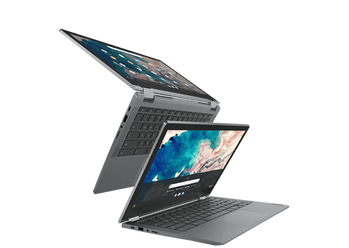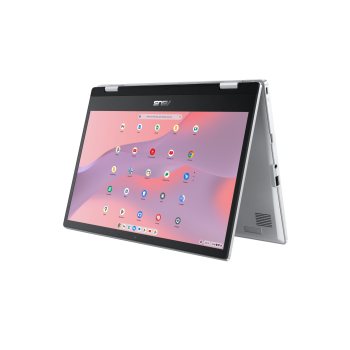- Affordable price
- Convertible design
- Good performance
- Flexible usage modes
- Premium build quality
- Immersive display
- Good battery life
- Limited storage
- Average build quality
- Limited RAM
- Average storage capacity
Lenovo Chromebook Flex 5 vs ASUS Chromebook Flip C434
The world of Chromebooks has exploded in recent years, with numerous manufacturers vying for market share. Two popular models that have garnered significant attention are the Lenovo Chromebook Flex 5 and the ASUS Chromebook Flip C434. Both devices are part of the Google laptops ecosystem, designed to provide seamless integration with Google's suite of productivity apps and services.
Design and Display
The Lenovo Chromebook Flex 5 boasts a sleek, convertible design that allows users to effortlessly switch between laptop and tablet modes. Its 13.3-inch Full HD touchscreen display is vibrant and responsive, making it ideal for streaming videos, browsing the web, or working on documents. The device's aluminum chassis provides durability and a premium feel, weighing in at just 2.97 pounds.
In contrast, the ASUS Chromebook Flip C434 features a stunning 14-inch Full HD touchscreen display with a NanoEdge design, which provides an immersive viewing experience with minimal bezels. The device's aluminum body is both sturdy and lightweight, tipping the scales at 3.2 pounds. While it also offers a convertible design, the Flip C434's hinge feels slightly more rigid than the Flex 5's, providing a more stable typing experience.
Performance
Both Chromebooks are powered by Intel Core processors, but the ASUS Chromebook Flip C434 has a slight edge in terms of raw processing power. The device comes with up to an 8th Gen Intel Core i7-10510U processor, paired with up to 8GB of RAM and 128GB of eMMC storage. This configuration provides smooth performance for demanding tasks like video editing, multitasking, and Android app emulation.
The Lenovo Chromebook Flex 5, on the other hand, is powered by up to an 10th Gen Intel Core i5-10210U processor, paired with up to 8GB of RAM and 64GB of eMMC storage. While it may not match the Flip C434's processing prowess, the Flex 5 still delivers excellent performance for everyday tasks like browsing, email, and document editing.
Battery Life
When it comes to battery life, the Lenovo Chromebook Flex 5 has a slight advantage. The device can last up to 10 hours on a single charge, making it perfect for long trips or extended work sessions. In contrast, the ASUS Chromebook Flip C434's battery life is rated at up to 8 hours, although real-world usage may vary depending on factors like screen brightness and Wi-Fi connectivity.
Ports and Connectivity
Both devices offer a range of ports and connectivity options, including USB-A, USB-C, HDMI, and microSD card slots. However, the ASUS Chromebook Flip C434 has an additional USB-A port, making it more convenient for users who need to connect multiple peripherals at once. The device also features Wi-Fi 6 (802.11ax) support, providing faster and more reliable wireless connectivity.
Conclusion
Ultimately, the choice between the Lenovo Chromebook Flex 5 and the ASUS Chromebook Flip C434 depends on your specific needs and preferences. If you prioritize a more portable design, longer battery life, and a lower price point, the Flex 5 may be the better option. On the other hand, if you need more processing power, a larger display, and additional ports, the Flip C434 is an excellent choice.
As part of the Google laptops family, both devices offer seamless integration with Google Drive, Google Docs, and other popular productivity apps. Whether you're a student, professional, or simply looking for a reliable device for everyday use, these Chromebooks are sure to impress. With their sleek designs, impressive performance, and affordable prices, they're an excellent alternative to traditional laptops, making them a compelling option for anyone in the market for a new Google laptop.


























